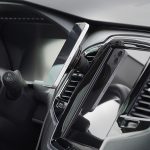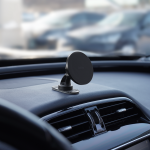Qi2 promises to bring MagSafe magnetic attachment and charging to iPhones and Android devices alike. The problem? So far, only the iPhone series 12, 13, 14, and 15 offer Qi2 support. It’s rumored that the Pixel 9 will be the first Qi2-certified Android phone. However, at this point, that’s still just speculation.
So, what if you have an Android phone, but you want to use a MagSafe or Qi2 phone charger?
Many companies offer metal attachments that can be installed on your Android smartphone or phone case to add MagSafe compatibility. But what a lot of consumers don’t realize is that these attachments can actually interfere with wireless charging.
Read on to learn more about the pitfalls of metal attachments and what you as an Android user can do instead to add MagSafe and Qi2 compatibility to your device.
HOW DOES WIRELESS CHARGING WORK?
Wireless charging operates based on the principle of electromagnetic fields.
The wireless charger creates a magnetic field by running a current through a coil, which then induces a current in the wireless charging coil in your smartphone. This current is what charges the battery in your phone.
MagSafe (and now Qi2) chargers decrease the amount of energy lost between the charger and your phone by using magnets to perfectly align those two coils. This is why official MagSafe and Qi2 chargers are able to charge devices at speeds of up to 15W.

WHAT HAPPENS WHEN YOU USE A METAL ATTACHMENT?
In order to allow Android smartphones and cases to take advantage of MagSafe technology, many companies have started selling metal attachments.
These attachments can be installed on the back of phones and cases to create a magnetic connection with MagSafe and now Qi2 chargers. The problem is that these attachments are not 100% magnetic.
When you place a metal attachment between your Android smartphone and a MagSafe or Qi2 charger that is not 100% magnetic, the attachment can interfere with the creation of the magnetic field and disrupt the current. This can result in slower charging speeds and, in some cases, prevent charging altogether.
When using metal attachments that are not 100% magnetic, there is also the risk of overheating, which can pose a threat to both the smartphone and the user.

HOW CAN ANDROID USERS ADD MAGSAFE & QI2 COMPATIBILITY TO THEIR DEVICES?
The best way to ensure a fast – and safe – wireless connection between your Android device and a MagSafe or Qi2 charger is to use an attachment that is 100% magnetic.
Last month, we launched the iOttie Magnetic Ring Adapter. Unlike other metal attachments, our adapter is made with powerful N52 magnets and is 100% magnetic, ensuring your phone stays attached to MagSafe and Qi2 chargers, while alleviating concerns about overheating and wireless charging interference.
Each box includes two magnetic rings, two sets of cleaning wipes, and an alignment guide that makes installing the ring straightforward and easy.
To get the best MagSafe or Qi2 wireless charging experience with your Android phone, remove any metal attachments and try the new iOttie Magnetic Adapter Ring instead. Available for purchase on our website and Amazon.com.












